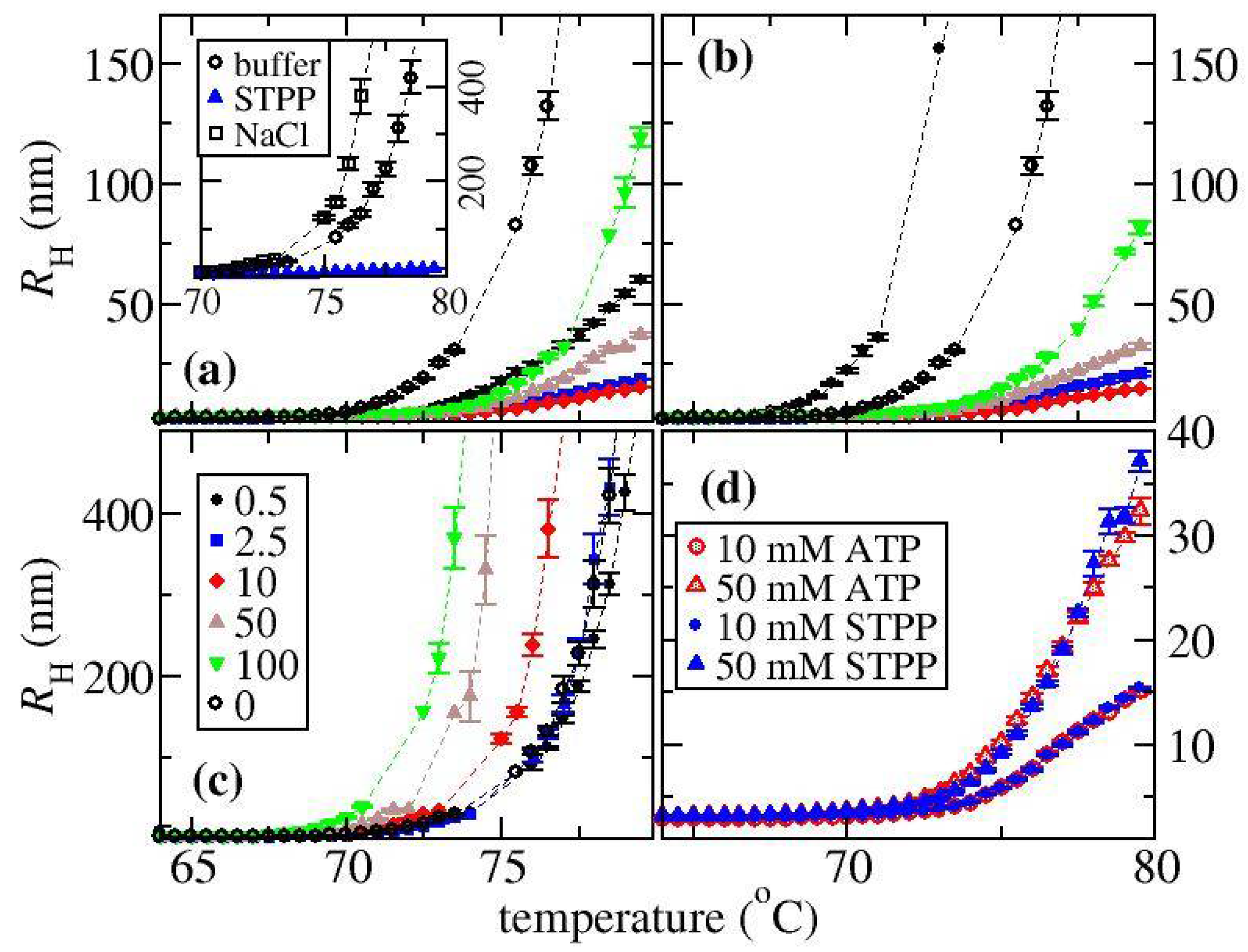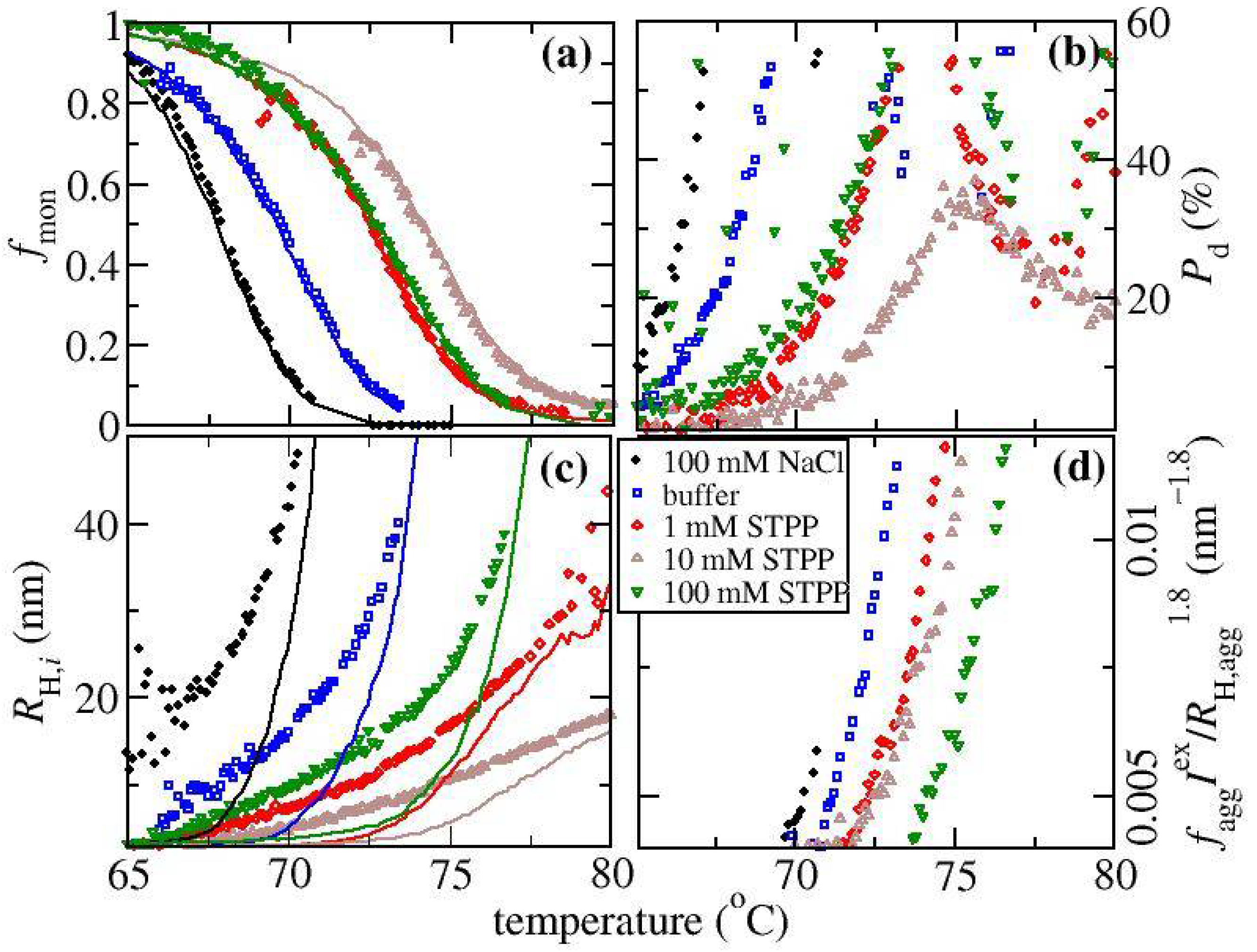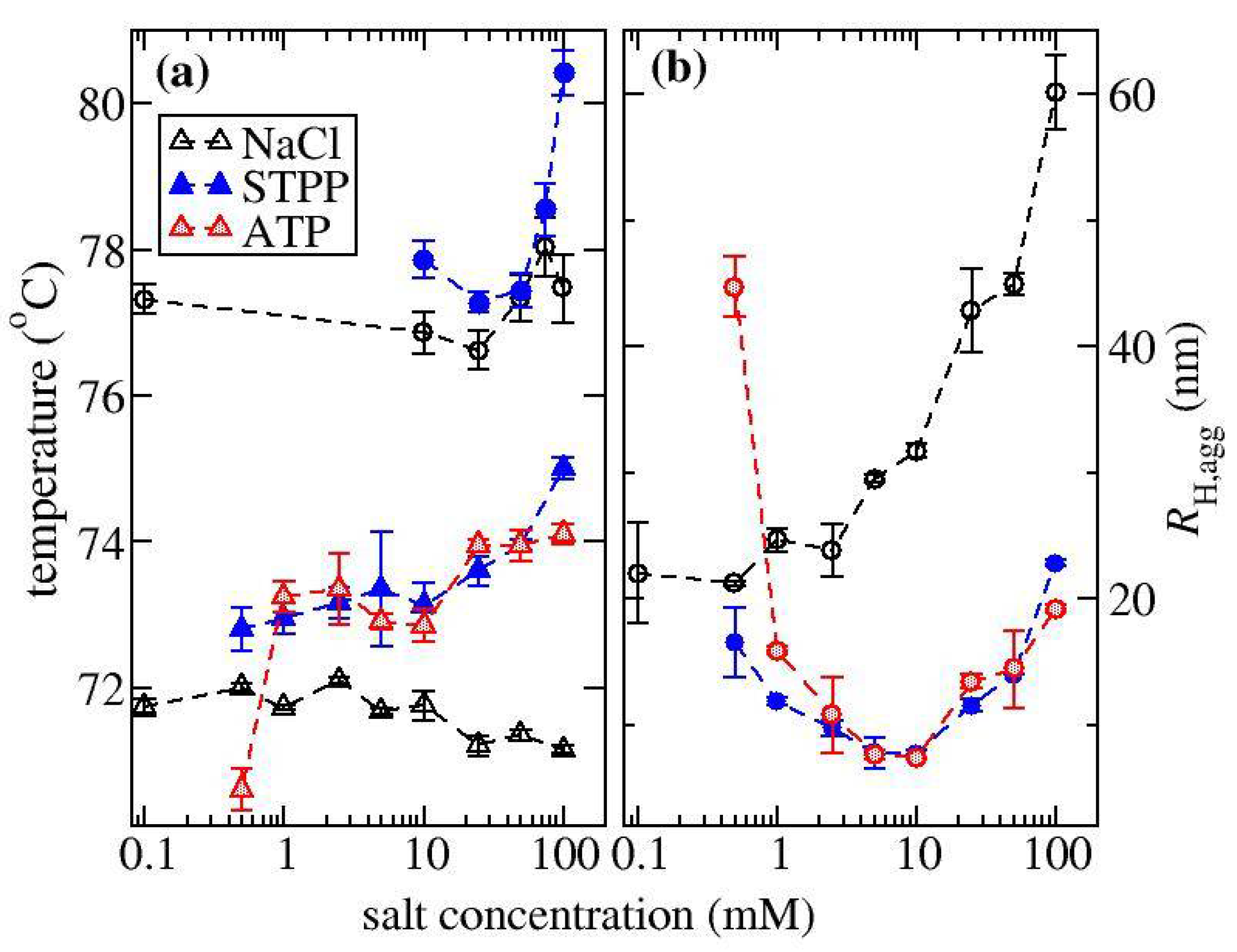ATP and Tri-Polyphosphate (TPP) Suppress Protein Aggregate Growth by a Supercharging Mechanism
Abstract
:1. Introduction
2. Materials and Methods
2.1. Materials
2.2. Sample Preparation
2.3. ζ-Potential Measurements
2.4. Temperature Ramped Dynamic Light Scattering (DLS and SLS)
2.5. Temperature Ramped Thermal Stability to Determine Tm
2.6. Size Exclusion Chromatography Multiangle Laser Light Scattering (SEC-MALLS)
2.7. Determination by SLS
3. Results
3.1. ζ-Potential Measurements
3.2. Thermally Induced Aggregation Experiments
3.3. Analysis of Ovalbumin Thermal Ramp Data Suggests STPP Alters Aggregate Growth Rates
3.4. SEC-MALLS Measurements Indicate TPP Suppresses Aggregate Growth
3.5. RNase A and Lysozyme
3.6. Values Indicate ATP/TPP Overcharging Increases Protein–Protein Electrostatic Repulsion for Ovalbumin, but Not for α-Cgn
3.7. Aggregate Growth Rates Show Stronger Correlation with FUCHS Factor Than
3.8. ATP Attenuates Native-State Attractive Interactions between Ovalbumin Molecules
4. Discussion
5. Conclusions
Supplementary Materials
Author Contributions
Funding
Institutional Review Board Statement
Informed Consent Statement
Data Availability Statement
Acknowledgments
Conflicts of Interest
References
- Wang, W.; Singh, S.K.; Li, N.; Toler, M.R.; King, K.R.; Nema, S. Immunogenicity of protein aggregates-Concerns and realities. Int. J. Pharm. 2012, 431, 1–11. [Google Scholar] [CrossRef]
- Wang, W.; Singh, S.; Zeng, D.L.; King, K.; Nema, S. Antibody structure, instability, and formulation. J. Pharm. Sci. 2007, 96, 1–26. [Google Scholar] [CrossRef]
- Harris, R.J.; Shire, S.J.; Winter, C. Commercial manufacturing scale formulation and analytical characterization of therapeutic recombinant antibodies. Drug Dev. Res. 2004, 61, 137–154. [Google Scholar] [CrossRef]
- Evans, J.B.; Syed, B.A. Next-generation antibodies. Nat. Rev. Drug Discov. 2014, 13, 413–414. [Google Scholar] [CrossRef]
- Beck, A.; Wurch, T.; Bailly, C.; Corvaia, N. Strategies and challenges for the next generation of therapeutic antibodies. Nat. Rev. Immunol. 2010, 10, 345–352. [Google Scholar] [CrossRef]
- Lawrence, M.S.; Phillips, K.J.; Liu, D.R. Supercharging proteins can impart unusual resilience. J. Am. Chem. Soc. 2007, 129, 10110–10112. [Google Scholar] [CrossRef] [Green Version]
- Simeonov, P.; Berger-Hoffmann, R.; Hoffmann, R.; Straeter, N.; Zuchner, T. Surface supercharged human enteropeptidase light chain shows improved solubility and refolding yield. Protein Eng. Des. Sel. 2011, 24, 261–268. [Google Scholar] [CrossRef] [Green Version]
- Miklos, A.E.; Kluwe, C.; Der, B.S.; Pai, S.; Sircar, A.; Hughes, R.A.; Berrondo, M.; Xu, J.; Codrea, V.; Buckley, P.E.; et al. Structure-based design of supercharged, highly thermoresistant antibodies. Chem. Biol. 2012, 19, 449–455. [Google Scholar] [CrossRef] [Green Version]
- Schaefer, J.V.; Plueckthun, A. Engineering Aggregation Resistance in IgG by two independent mechanisms: Lessons from comparison of pichia pastoris and mammalian cell expression. J. Mol. Biol. 2012, 417, 309–335. [Google Scholar] [CrossRef]
- Der, B.S.; Kluwe, C.; Miklos, A.E.; Jacak, R.; Lyskov, S.; Gray, J.J.; Georgiou, G.; Ellington, A.D.; Kuhlman, B. Alternative computational protocols for supercharging protein surfaces for reversible unfolding and retention of stability. PLoS ONE 2013, 8, e64363. [Google Scholar] [CrossRef] [Green Version]
- Austerberry, J.I.; Dajani, R.; Panova, S.; Roberts, D.; Golovanov, A.P.; Pluen, A.; van der Walle, C.F.; Uddin, S.; Warwicker, J.; Derrick, J.P.; et al. The effect of charge mutations on the stability and aggregation of a human single chain Fv fragment. Eur. J. Pharm. Biopharm. 2017, 115, 18–30. [Google Scholar] [CrossRef] [Green Version]
- Menzen, T.; Friess, W. Temperature-Ramped studies on the aggregation, unfolding, and interaction of a therapeutic monoclonal antibody. J. Pharm. Sci. 2014, 103, 445–455. [Google Scholar] [CrossRef]
- Brummitt, R.K.; Nesta, D.P.; Chang, L.Q.; Chase, S.F.; Laue, T.M.; Roberts, C.J. Nonnative aggregation of an IgG1 antibody in acidic conditions: Part 1. unfolding, colloidal interactions, and formation of high-molecular-weight aggregates. J. Pharm. Sci. 2011, 100, 2087–2103. [Google Scholar] [CrossRef]
- Kim, N.; Remmele, R.L., Jr.; Liu, D.; Razinkov, V.I.; Fernandez, E.J.; Roberts, C.J. Aggregation of anti-streptavidin immunoglobulin gamma-1 involves Fab unfolding and competing growth pathways mediated by pH and salt concentration. Biophys. Chem. 2013, 172, 26–36. [Google Scholar] [CrossRef]
- Li, Y.; Ogunnaike, B.A.; Roberts, C.I. Multi-variate approach to global protein aggregation behavior and kinetics: Effects of pH, NaCl, and temperature for alpha-chymotrypsinogen A. J. Pharm. Sci. 2010, 99, 645–662. [Google Scholar] [CrossRef]
- Chi, E.Y.; Krishnan, S.; Kendrick, B.S.; Chang, B.S.; Carpenter, J.F.; Randolph, T.W. Roles of conformational stability and colloidal stability in the aggregation of recombinant human granulocyte colony-stimulating factor. Protein Sci. 2003, 12, 903–913. [Google Scholar] [CrossRef] [Green Version]
- Sahin, E.; Grillo, A.O.; Perkins, M.D.; Roberts, C.J. Comparative Effects of pH and ionic strength on protein-protein interactions, unfolding, and aggregation for IgG1 antibodies. J. Pharm. Sci. 2010, 99, 4830–4848. [Google Scholar] [CrossRef]
- Brummitt, R.K.; Nesta, D.P.; Chang, L.; Kroetsch, A.M.; Roberts, C.J. Nonnative aggregation of an IgG1 antibody in acidic conditions, part 2: Nucleation and growth kinetics with competing growth mechanisms. J. Pharm. Sci. 2011, 100, 2104–2119. [Google Scholar] [CrossRef]
- Barnett, G.V.; Qi, W.; Amin, S.; Lewis, E.N.; Razinkov, V.I.; Kerwin, B.A.; Liu, Y.; Roberts, C.J. Structural changes and aggregation mechanisms for anti-streptavidin IgG1 at elevated concentration. J. Phys. Chem. B 2015, 119, 15150–15163. [Google Scholar] [CrossRef]
- Nicoud, L.; Sozo, M.; Arosio, P.; Yates, A.; Norrant, E.; Morbidelli, M. Role of cosolutes in the aggregation kinetics of monoclonal antibodies. J. Phys. Chem. B 2014, 118, 11921–11930. [Google Scholar] [CrossRef]
- Jain, S.; Wheeler, J.R.; Walters, R.W.; Agrawal, A.; Barsic, A.; Parker, R. ATPase-modulated stress granules contain a diverse proteome and substructure. Cell 2016, 164, 487–498. [Google Scholar] [CrossRef] [Green Version]
- Patel, A.; Malinovska, L.; Saha, S.; Wang, J.; Alberti, S.; Krishnan, Y.; Hyman, A.A. ATP as a biological hydrotrope. Science 2017, 356, 753–756. [Google Scholar] [CrossRef]
- Sridharan, S.; Kurzawa, N.; Werner, T.; Guenthner, I.; Helm, D.; Huber, W.; Bantscheff, M.; Savitski, M.M. Proteome-wide solubility and thermal stability profiling reveals distinct regulatory roles for ATP. Nat. Commun. 2019, 10, 1155. [Google Scholar] [CrossRef] [Green Version]
- Greiner, J.V.; Glonek, T. Hydrotropic function of ATP in the crystalline lens. Exp. Eye Res. 2020, 190, 107862. [Google Scholar] [CrossRef]
- Song, J. Adenosine triphosphate energy-independently controls protein homeostasis with unique structure and diverse mechanisms. Protein Sci. 2021, 30, 1277. [Google Scholar] [CrossRef]
- Mehringer, J.; Do, T.-M.; Touraud, D.; Hohenschutz, M.; Khoshsima, A.; Horinek, D.; Kunz, W. Hofmeister versus Neuberg: Is ATP really a biological hydrotrope? Cell Rep. Phys. Sci. 2021, 2, 100343. [Google Scholar] [CrossRef]
- Lenton, S.; Hervo-Hansen, S.; Popov, A.M.; Tully, M.D.; Lund, M.; Skepo, M. Impact of Arginine-phosphate interactions on the reentrant condensation of disordered proteins. Biomacromolecules 2021, 22, 1532–1544. [Google Scholar] [CrossRef]
- Dang, M.; Song, J. ALS-causing D169G mutation disrupts the ATP-binding capacity of TDP-43 RRM1 domain. Biochem. Biophys. Res. Commun. 2020, 524, 459–464. [Google Scholar] [CrossRef]
- Nishizawa, M.; Walinda, E.; Morimoto, D.; Kohn, B.; Scheler, U.; Shirakawa, M.; Sugase, K. Effects of weak nonspecific interactions with ATP on proteins. J. Am. Chem. Soc. 2021, 143, 11982–11993. [Google Scholar] [CrossRef]
- Bye, J.W.; Curtis, R.A. Controlling phase separation of lysozyme with polyvalent anions. J. Phys. Chem. B 2019, 123, 593–605. [Google Scholar] [CrossRef] [Green Version]
- Roberts, D.; Keeling, R.; Tracka, M.; van der Walle, C.F.; Uddin, S.; Warwicker, J.; Curtis, R. The role of electrostatics in protein-protein interactions of a monoclonal antibody. Mol. Pharm. 2014, 11, 2475–2489. [Google Scholar] [CrossRef] [PubMed]
- Holloway, L.; Roche, A.; Marzouk, S.; Uddin, S.; Ke, P.; Ekizoglou, S.; Curtis, R. Determination of Protein-protein interactions at high co-solvent concentrations using static and dynamic light scattering. J. Pharm. Sci. 2020, 109, 2699–2709. [Google Scholar] [CrossRef] [PubMed]
- Gruenberger, A.; Lai, P.-K.; Blanco, M.A.; Roberts, C.J. Coarse-grained modeling of protein second osmotic virial coefficients: Sterics and short-ranged attractions. J. Phys. Chem. B 2013, 117, 763–770. [Google Scholar] [CrossRef] [PubMed]
- Zhang, F.; Weggler, S.; Ziller, M.J.; Ianeselli, L.; Heck, B.S.; Hildebrandt, A.; Kohlbacher, O.; Skoda, M.W.A.; Jacobs, R.M.J.; Schreiber, F. Universality of protein reentrant condensation in solution induced by multivalent metal ions. Proteins 2010, 78, 3450–3457. [Google Scholar] [CrossRef] [PubMed]
- Erickson, H.P. Size and shape of protein molecules at the nanometer level determined by sedimentation, gel filtration, and electron microscopy. Biol. Proced. Online 2009, 11, 32–51. [Google Scholar] [CrossRef] [Green Version]
- Hanlon, A.D.; Larkin, M.I.; Reddick, R.M. Free-solution, label-free protein-protein interactions characterized by dynamic light scattering. Biophys. J. 2010, 98, 297–304. [Google Scholar] [CrossRef] [Green Version]
- Jachimska, B.; Wasilewska, M.; Adamczyk, Z. Characterization of globular protein solutions by dynamic light scattering, electrophoretic mobility, and viscosity measurements. Langmuir 2008, 24, 6866–6872. [Google Scholar] [CrossRef]
- Li, Y.; Roberts, C.J. Lumry-Eyring Nucleated-Polymerization Model of protein aggregation kinetics. 2. Competing Growth via condensation and chain polymerization. J. Phys. Chem. B 2009, 113, 7020–7032. [Google Scholar] [CrossRef] [Green Version]
- Weijers, M.; Visschers, R.W.; Nicolai, T. Light scattering study of heat-induced aggregation and gelation of ovalbumin. Macromolecules 2002, 35, 4753–4762. [Google Scholar] [CrossRef]
- Broersen, K.; Weijers, M.; de Groot, J.; Hamer, R.J.; de Jongh, H.H.J. Effect of protein charge on the generation of aggregation-prone conformers. Biomacromolecules 2007, 8, 1648–1656. [Google Scholar] [CrossRef]
- Choi, S.J.; Moon, T.W. Influence of sodium chloride and glucose on the aggregation behavior of heat-denatured ovalbumin investigated with a multiangle laser light scattering technique. J. Food Sci. 2008, 73, C41–C49. [Google Scholar] [CrossRef] [PubMed]
- Delahaije, R.J.B.M.; Wierenga, P.A.; Giuseppin, M.L.F.; Gruppen, H. Comparison of heat-induced aggregation of globular proteins. J. Agric. Food Chem. 2015, 63, 5257–5265. [Google Scholar] [CrossRef] [PubMed]
- Weijers, M.; Broersen, K.; Barneveld, P.A.; Stuart, M.A.C.; Hamer, R.J.; De Jongh, H.J.; Visschers, R.W. Net charge affects morphology and visual properties of ovalbumin aggregates. Biomacromolecules 2008, 9, 3165–3172. [Google Scholar] [CrossRef]
- Cosgrove, D.J. Chemistry and biochemistry of inositol polyphosphates. Rev. Pure Appl. Chem. 1966, 16, 209–224. [Google Scholar]
- Alberty, R.A.; Smith, R.M.; Bock, R.M. The Apparent ionization constants of the adenosinephosphates and related compounds. J. Biol. Chem. 1951, 193, 425–434. [Google Scholar] [CrossRef]
- Arzensek, D.; Kuzman, D.; Podgornik, R. Colloidal interactions between monoclonal antibodies in aqueous solutions. J. Colloid Interface Sci. 2012, 384, 207–216. [Google Scholar] [CrossRef] [PubMed]
- Eberstein, W.; Georgalis, Y.; Saenger, W. Molecular interactions in crystallizing lysozyme solutions studied by photon-correlation spectroscopy. J. Cryst. Growth 1994, 143, 71–78. [Google Scholar] [CrossRef]
- Muschol, M.; Rosenberger, F. Interactions in undersaturated and supersaturated lysozyme solutions: Static and dynamic light scattering results. J. Chem. Phys. 1995, 103, 10424–10432. [Google Scholar] [CrossRef]
- Ma, Y.; Acosta, D.M.; Whitney, J.R.; Podgornik, R.; Steinmetz, N.F.; French, R.H.; Parsegian, V.A. Determination of the second virial coefficient of bovine serum albumin under varying pH and ionic strength by composition-gradient multi-angle static light scattering. J. Biol. Phys. 2015, 41, 85–97. [Google Scholar] [CrossRef] [Green Version]
- Neal, B.L.; Asthagiri, D.; Velev, O.D.; Lenhoff, A.M.; Kaler, E.W. Why is the osmotic second virial coefficient related to protein crystallization? J. Cryst. Growth 1999, 196, 377–387. [Google Scholar] [CrossRef]
- Neal, B.L.; Asthagiri, D.; Lenhoff, A.M. Molecular origins of osmotic second virial coefficients of proteins. Biophys. J. 1998, 75, 2469–2477. [Google Scholar] [CrossRef] [Green Version]
- Elcock, A.H.; McCammon, J.A. Calculation of weak protein-protein interactions: The pH dependence of the second virial coefficient. Biophys. J. 2001, 80, 613–625. [Google Scholar] [CrossRef] [Green Version]
- Nicoud, L.; Arosio, P.; Sozo, M.; Yates, A.; Norrant, E.; Morbidelli, M. Kinetic analysis of the multistep aggregation mechanism of monoclonal antibodies. J. Phys. Chem. B 2014, 118, 10595–10606. [Google Scholar] [CrossRef] [PubMed]
- Rubin, J.; San Miguel, A.; Bommarius, A.S.; Behrens, S.H. Correlating Aggregation Kinetics and stationary diffusion in protein-sodium salt systems observed with dynamic light scattering. J. Phys. Chem. B 2010, 114, 4383–4387. [Google Scholar] [CrossRef] [PubMed]
- Arosio, P.; Rima, S.; Lattuada, M.; Morbidelli, M. Population balance modeling of antibodies aggregation kinetics. J. Phys. Chem. B 2012, 116, 7066–7075. [Google Scholar] [CrossRef]
- Olsen, S.N.; Andersen, K.B.; Randolph, T.W.; Carpenter, J.F.; Westh, P. Role of electrostatic repulsion on colloidal stability of Bacillus halmapalus alpha-amylase. Biochim. Biophys. Acta Proteins Proteom. 2009, 1794, 1058–1065. [Google Scholar] [CrossRef]
- Nakamura, R.; Hirai, M.; Takemori, Y. Studies on ovalbumin-s-ovalbumin transformation. 1. Some differences noted between the properties of ovalbumin and s-ovalbumin in native-state. Agric. Biol. Chem. 1980, 44, 149–153. [Google Scholar] [CrossRef] [Green Version]
- Mitchell, D.J.; Ninham, B.W. Range of screened coulomb interaction in electrolytes and double-layer problems. Chem. Phys. Lett. 1978, 53, 397–399. [Google Scholar] [CrossRef]
- Kjellander, R.; Mitchell, D.J. Dressed-ion theory for electrolyte-solutions—A Debye-Huckel-like reformulation of the exact theory for the primitive model. J. Chem. Phys. 1994, 101, 603–626. [Google Scholar] [CrossRef]
- Smith, R.M.; Alberty, R.A. The apparent stability constants of ionic complexes of various adenosine phosphates with monovalent cations. J. Phys. Chem. 1956, 60, 180–184. [Google Scholar] [CrossRef]
- Pilatus, U.; Mayer, A.; Ofermann, W.; Leibfrtiz, D. Sodium binding to and protonation of ATP—A multinuclear magnetic double-resonance study at 8.46 tesla. Biochim. Biophys. Acta 1987, 926, 106–113. [Google Scholar] [CrossRef]
- Andrews, J.M.; Roberts, C.J. A Lumry-Eyring nucleated polymerization model of protein aggregation kinetics: 1. Aggregation with pre-equilibrated unfolding. J. Phys. Chem. B 2007, 111, 7897–7913. [Google Scholar] [CrossRef] [PubMed]
- Roberts, C.J.; Blanco, M.A. Role of anisotropic interactions for proteins and patchy nanoparticles. J. Phys. Chem. B 2014, 118, 12599–12611. [Google Scholar] [CrossRef] [PubMed] [Green Version]
- Blanco, M.A.; Sahin, E.; Robinson, A.S.; Roberts, C.J. Coarse-grained model for colloidal protein interactions, B-22, and protein cluster formation. J. Phys. Chem. B 2013, 117, 16013–16028. [Google Scholar] [CrossRef] [PubMed] [Green Version]
- McManus, J.J.; Lomakin, A.; Ogun, O.; Pande, A.; Basan, M.; Pande, J.; Benedek, G.B. Altered phase diagram due to a single point mutation in human gamma D-crystallin. Proc. Natl. Acad. Sci. USA 2007, 104, 16856–16861. [Google Scholar] [CrossRef] [Green Version]
- Lomakin, A.; Asherie, N.; Benedek, G.B. Aeolotopic interactions of globular proteins. Proc. Natl. Acad. Sci. USA 1999, 96, 9465–9468. [Google Scholar] [CrossRef] [Green Version]
- McManus, J.J.; Charbonneau, P.; Zaccarelli, E.; Asherie, N. The physics of protein self-assembly. Curr. Opin. Colloid Interface Sci. 2016, 22, 73–79. [Google Scholar] [CrossRef] [Green Version]
- Pal, S.; Paul, S. ATP Controls the aggregation of A beta(16-22) peptides. J. Phys. Chem. B 2020, 124, 210–223. [Google Scholar] [CrossRef]
- Wennerstrom, H.; Estrada, E.V.; Danielsson, J.; Oliveberg, M. Colloidal stability of the living cell. Proc. Natl. Acad. Sci. USA 2020, 117, 10113–10121. [Google Scholar] [CrossRef] [Green Version]








Publisher’s Note: MDPI stays neutral with regard to jurisdictional claims in published maps and institutional affiliations. |
© 2021 by the authors. Licensee MDPI, Basel, Switzerland. This article is an open access article distributed under the terms and conditions of the Creative Commons Attribution (CC BY) license (https://creativecommons.org/licenses/by/4.0/).
Share and Cite
Bye, J.; Murray, K.; Curtis, R. ATP and Tri-Polyphosphate (TPP) Suppress Protein Aggregate Growth by a Supercharging Mechanism. Biomedicines 2021, 9, 1646. https://doi.org/10.3390/biomedicines9111646
Bye J, Murray K, Curtis R. ATP and Tri-Polyphosphate (TPP) Suppress Protein Aggregate Growth by a Supercharging Mechanism. Biomedicines. 2021; 9(11):1646. https://doi.org/10.3390/biomedicines9111646
Chicago/Turabian StyleBye, Jordan, Kiah Murray, and Robin Curtis. 2021. "ATP and Tri-Polyphosphate (TPP) Suppress Protein Aggregate Growth by a Supercharging Mechanism" Biomedicines 9, no. 11: 1646. https://doi.org/10.3390/biomedicines9111646




